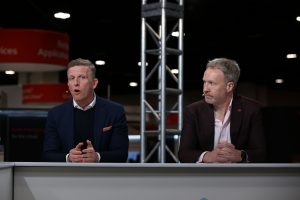 NEWS
NEWS
 NEWS
NEWS
 NEWS
NEWS
While containerization often dominates tech discussions, modern virtualization remains a cornerstone in enterprise IT.
As the landscape evolves, companies are increasingly seeking platforms that can efficiently manage a diverse array of workloads, from containers to serverless and AI applications. Industry leaders such as Red Hat Inc. and Pure Storage Inc. are at the forefront of this shift, equipping themselves to ride the modern virtualization wave and meet the complex demands of today’s digital infrastructure.
“We went about building a platform that can cater to those types of workloads in one unified platform, one unified management solution,” said Steve Gordon (pictured, right), senior director of product management, hybrid platforms, at Red Hat. “But then the other thing that’s more recent that’s happening is there is a market dynamic that’s been introduced where customers are now evaluating their options for their virtualization estate that’s been sitting there for 10 to 15 years. They have become very motivated to find ways to manage their risk and the cost of those environments going forward.”
Gordon and Andrew Custard (left), vice president of global sales, Portworx, at Pure Storage Inc. spoke with theCUBE Research’s Rebecca Knight and Paul Gillin at Red Hat Summit, during an exclusive broadcast on theCUBE, SiliconANGLE Media’s livestreaming studio. They discussed the complexities and opportunities in modernizing virtualization, focusing on flexibility, collaboration and innovation as organizations wade through this evolving landscape. (* Disclosure below.)

Analyzing the complexities and demands of modern virtualization with Red Hat’s Steve Gordon and Portworx’s Andrew Custard.
With virtualization, modernization isn’t merely about moving forward. It’s about embracing the complexities of legacy systems and integrating them seamlessly into a modern, agile infrastructure, according to Custard.
“Sometimes it also just gets to that environment has been around for a long time, and the definition of what’s possible in best practices has changed,” he said. “You now have a lot of different ways that you can be able to solve for the problem. As those ideas of best practices evolve, the responsibility of most CTOs is to be able to look and say, ‘All right, are we building the best possible path?'”
Red Hat’s approach to modern virtualization leverages Linux virtualization by containerizing virtual machines. By doing so, the company ensures that both containers and virtual machines can be managed using the same interfaces and integrated into the same ecosystem of cloud-native technologies, Gordon added.
“That’s where we really have taken advantage now of, not only running on one platform gives you the advantage from management perspective, but then you connect to that entire ecosystem around cloud native technology where we have a lot of exciting new things you can do with virtual machine,” he said. “You can include it in a service mesh, you can use it in a GitOps pipeline using adjacent cloud native technologies. Then with Portworx, this great story of where you can also use that same cloud-native storage solution across the containers and virtual machines as well, and storage is a critical capability for virtual machines.”
Here’s the complete video interview, part of SiliconANGLE’s and theCUBE Research’s coverage of Red Hat Summit:
(* Disclosure: Portworx by Pure Storage Inc. sponsored this segment of theCUBE. Neither Portworx nor other sponsors have editorial control over content on theCUBE or SiliconANGLE.)
Support our mission to keep content open and free by engaging with theCUBE community. Join theCUBE’s Alumni Trust Network, where technology leaders connect, share intelligence and create opportunities.
Founded by tech visionaries John Furrier and Dave Vellante, SiliconANGLE Media has built a dynamic ecosystem of industry-leading digital media brands that reach 15+ million elite tech professionals. Our new proprietary theCUBE AI Video Cloud is breaking ground in audience interaction, leveraging theCUBEai.com neural network to help technology companies make data-driven decisions and stay at the forefront of industry conversations.